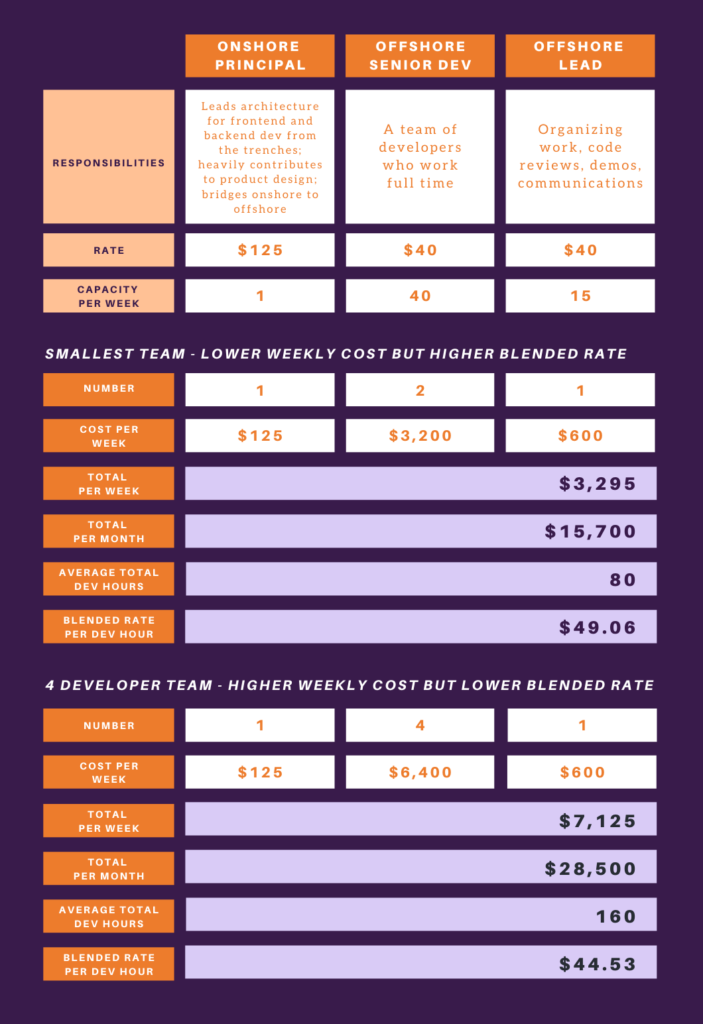It often starts the same way. Management demands a budget and schedule for a project that hasn’t been scoped. The team is busy doing maintenance and other initiatives. Budgets and schedules are never right anyway. The temptation is to throw together rough estimates and hope for the best. But there’s a better way.
Try a three-staged approach. The goal of Stage 1 is to reach a go/no-go decision at the lowest investment of time and money.
This gives management what they want – a commitment to deliver a budget and schedule in two or three weeks. It allows tech leaders to shine for delivering on-time and on-budget. The key is putting the right things into the Stage 1 Estimate.
Here’s how we break it down:
Stage 1: Estimate
This is a zero-commitment stage. That means some projects won’t advance to Stage 2. The goal of this stage is to decide as quickly and cheaply as possible if it makes sense to move forward with the project.
Deliverable #1: User Flow Diagram.
- Flow diagram for all users.
- Where each user can go and what they can do.
- 60% Project understanding.
Deliverable #2: Technical Spec.
- Entity diagram.
- Integrations.
- Reveals data model and complexity.
- Increases project understanding to 75%.
Deliverable #3: Project Scope.
- People, and type of team required to build the system.
- Rough Estimated cost.
- Rough timeline.
- Increases project understanding to 80%.
Stage 2: Plan
Proceed to this stage only if the Stage 1 Estimate provides a compelling case to move forward. The timeline and budget are further refined in this stage.
Deliverable #1: High fidelity wireframe.
- Develop and finalize the look, feel and dimensions.
- Finalize fonts and colors. These should not change after this stage.
- Define presumed content and images. Consistent with Agile processes, these may change based on demo testing.
Deliverable #2: Dev Spec.
- Define how the system behaves.
- Describe, for each screen, the business processes and rules that need to be coded. Examples include default values, and types of inputs allowed.
- Define all business rules, defaults, configuration options, integrations, etc.
Deliverable #3: Detailed Estimate.
- Develop a detailed development spec based on the dev spec, wireframes, entity diagram and integrations.
- Pad for known knowns and known unknowns to ensure there are no surprises.
Deliverable #4: Configured Project Planning Tool.
- Load all Epics and User Stories needed to build the system into your project management tool (i.e.Jira, AzureDevOps, etc.)
- Tag all User Stories as MVP for easy change request management.
- Add estimates.
Stage 3: Execute
Completing stages 1 & 2 defines a clear path of execution with 80% understanding on requirements. We use Agile processes to get to 100% project understanding. So, we add a 20% buffer to account for this known unknown. But the timeline risk and budget risk are minimized by formalizing the definitions in stages 1 & 2.
Most Vice Software projects:
- Take 3-6 months to complete.
- Have development teams costing $14-25k a month depending on team size.
- Have design costs between $5-10k.
Require a deposit of $12-30k before development begins depending on the size of the project.
Here’s an example of a typical project in the execution stage:

Getting Started
Roughly 49% of companies spend $5,000 to $25,000 to develop an initial concept (Stage 1: Estimate). Our goal is for you to reach a go/no-go decision much cheaper and within two or three weeks.
For qualified organizations, we’ll execute on the Stage 1 Deliverables for less than $1000. These include:
- User flow diagram.
- Technical spec.
- Project scope.
Because we believe everyone benefits from quick clarity on the road ahead.
 Schedule a call to get the Phase 1 Deliverables for your organization. This will take you to 80% understanding of your project in 2-3 weeks so you can make a go / no-go decision.
Schedule a call to get the Phase 1 Deliverables for your organization. This will take you to 80% understanding of your project in 2-3 weeks so you can make a go / no-go decision.
